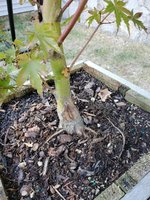Prozart
Seedling
I got into bonsai a couple months ago, and since there's not a lot to do this time of year I've just been reading everything I can on various websites (this one included) and Reddit. I purchased an acer palmatum a little over a month ago from a nursery and am planning to chop the trunk to develop taper, but I've read some contradictory information and wanted to get some clarification here if I could.
According to this article on bonsai4me (http://bonsai4me.com/AdvTech/ATdevelopingtrunksforbonsai.htm) once you chop the trunk the lower portion stops thickening until the new leader becomes as thick as the old trunk, so you don't want to perform the first chop until the bottom portion is as thick as you want it to be.
According to this article on EverGreenGardenWorks (https://www.evergreengardenworks.com/trunks.htm) says chopping will only slow down the growth of the bottom part, so you want to perform the first chop when the bottom part is half to two thirds the desired end thickness.
In my current situation, the bottom portion is a little over an inch and the flare is a little over an inch and a half. I probably want the end thickness to be around 2 inches with the flare being 3 inches or so. So, according to Evergreen, I should do the chop now but according to Bonsai4Me I should wait until I get the trunk where I want it. I'm surprised there is this contradictory information out there, it seems like it would be a pretty easy thing to test given a few years: measure the caliper, chop, then measure the caliper a couple years later.
Anyway, any information or help is greatly appreciated. I attached an image if anyone is interested. I'm not planning on doing a chop this year (as in Spring 2021) anyway as I want to plant it in the ground and let it grow for a year, but just wanted some feedback.

According to this article on bonsai4me (http://bonsai4me.com/AdvTech/ATdevelopingtrunksforbonsai.htm) once you chop the trunk the lower portion stops thickening until the new leader becomes as thick as the old trunk, so you don't want to perform the first chop until the bottom portion is as thick as you want it to be.
According to this article on EverGreenGardenWorks (https://www.evergreengardenworks.com/trunks.htm) says chopping will only slow down the growth of the bottom part, so you want to perform the first chop when the bottom part is half to two thirds the desired end thickness.
In my current situation, the bottom portion is a little over an inch and the flare is a little over an inch and a half. I probably want the end thickness to be around 2 inches with the flare being 3 inches or so. So, according to Evergreen, I should do the chop now but according to Bonsai4Me I should wait until I get the trunk where I want it. I'm surprised there is this contradictory information out there, it seems like it would be a pretty easy thing to test given a few years: measure the caliper, chop, then measure the caliper a couple years later.
Anyway, any information or help is greatly appreciated. I attached an image if anyone is interested. I'm not planning on doing a chop this year (as in Spring 2021) anyway as I want to plant it in the ground and let it grow for a year, but just wanted some feedback.



